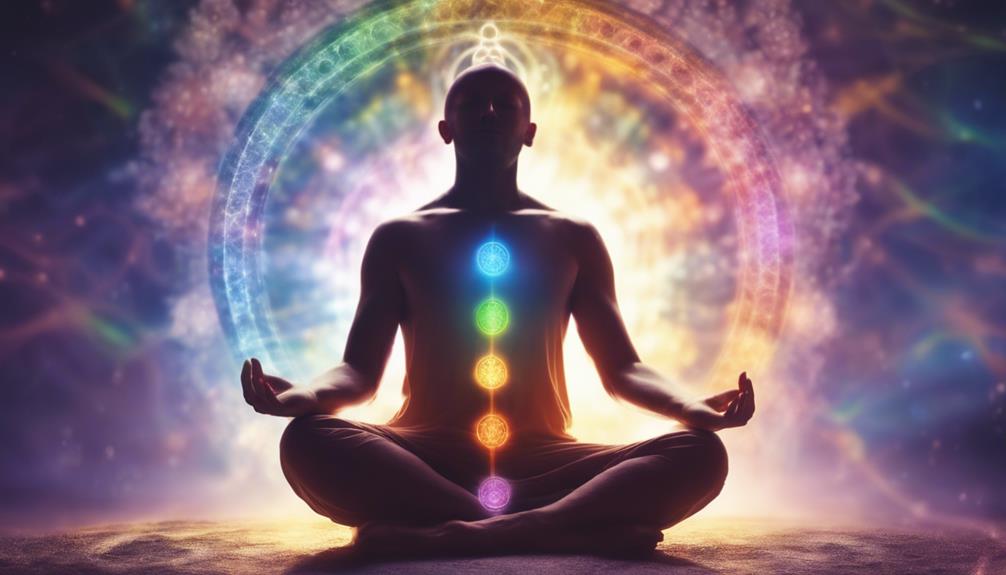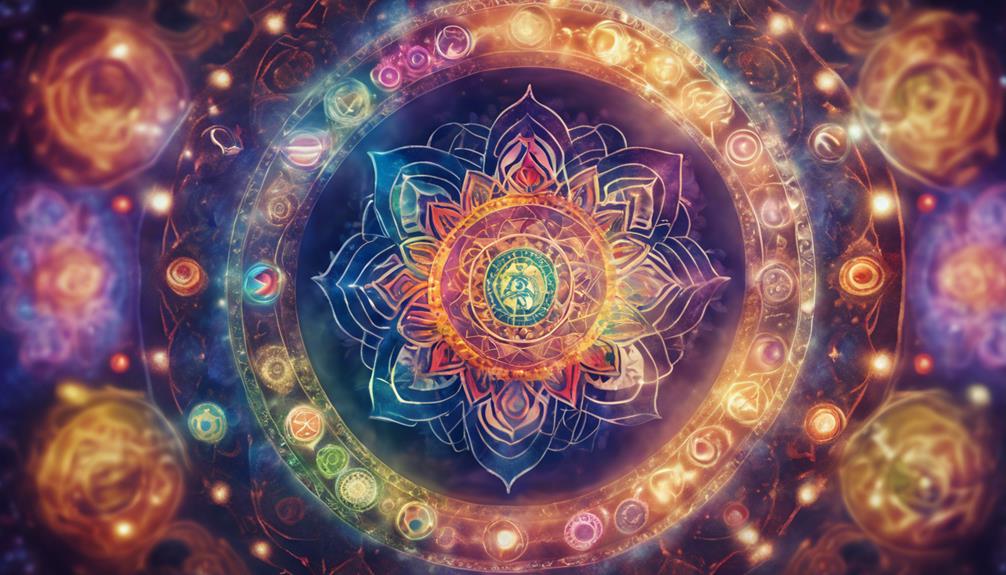When it comes to spiritual energy, various cultures use different terms like Qi, Prana, aura, chakras, and energy body. These terms represent the essence of spiritual energy from East Asian, Indian, and Western esoteric traditions. If you're curious about exploring more about these fascinating concepts and practices, you'll uncover a wealth of knowledge about how spiritual energy influences health, energy, balance, and overall well-being.
Key Takeaways
- In East Asian cultures, spiritual energy is called Qi.
- Indian spiritual traditions refer to spiritual energy as Prana.
- Western esoteric traditions associate spiritual energy with aura and chakras.
- Energy manipulation practices involve terms like Reiki and energy healing.
- Spiritual energy is also recognized as life force or élan vital.
Spiritual Energy in History
Throughout history, the concept of spiritual energy has intrigued and sparked debates among scholars and thinkers across cultures and time periods. Vitalism, a theory dating back to antiquity, proposed the existence of an essential energy field responsible for life and spiritual healing. This concept, also known as the life force or élan vital, gained significant attention in the 18th and 19th centuries with theories like animal magnetism.
German biologist Hans Driesch further explored these ideas in the early 20th century with his concept of entelechy.
Despite the historical prominence of these beliefs, modern science has largely discredited the association of additional energetic properties with life. Nonetheless, spiritual energy concepts continue to be debated and explored, with varying interpretations and beliefs shaping the understanding of energy fields and their role in spiritual healing practices throughout history.
Concepts of Energy in Spirituality

Spiritual energy manifests differently across various cultures and belief systems, embodying unique terms and concepts that reflect its significance in spiritual practices. Here are some key concepts related to energy in spirituality:
- Energy is often referred to as Qi in East Asian cultures, representing the life force within living beings and emphasizing the interconnectedness of the mind, body, and spirit.
- In Indian spiritual traditions, spiritual energy is known as Prana, believed to be the essential energy that sustains life and influences one's state of mind and overall well-being.
- Western esoteric traditions associate spiritual energy with terms like aura, chakras, or the energy body, highlighting the importance of balance and alignment for best health and spiritual growth.
- Some spiritual practices involve spending time manipulating spiritual energy through techniques like Reiki or energy healing, emphasizing the importance of channeling and directing this energy for healing and promoting balance in the body.
Sacred Locations and Energy
You're about to explore the fascinating world of sacred locations and the energy they're believed to possess. These sites, known as sacred energy sites, are considered numinous locations with deep spiritual significance.
Get ready to delve into scientific critiques and discussions surrounding the concept of energy at these revered places.
Sacred Energy Sites
Many cultures worldwide revere specific locations as sacred energy sites, attributing them with profound spiritual significance. These sites are believed to harness unique energies that can affect individuals in various ways.
Here are some key points to ponder regarding sacred energy sites:
- Cross-Cultural Significance: Sacred energy sites aren't limited to one culture or belief system; they're found globally, showcasing the universality of spiritual connections to certain places.
- Numinous Energy: Some sacred sites are thought to emanate numinous energy, which is believed to be transformative and healing for those who visit them.
- Criticism and Controversy: The concept of energy manipulation at sacred sites, particularly in New Age contexts, has faced skepticism from the scientific community, questioning the validity of such practices.
- Investigations and Debates: Practices like Reiki and energy manipulation at sacred sites have been subjected to scrutiny and debates to understand their efficacy and implications within spiritual contexts.
Numinous Locations
Sacred locations, known as numinous sites, hold special spiritual significance across various belief systems due to their perceived unique energy or vibrations. These sites are believed to help us connect with the divine, facilitate personal growth, and enhance spiritual practices.
Whether for personal or professional reasons, visiting these numinous locations can offer a sense of peace and clarity that's often easier said than done to achieve elsewhere.
For many individuals, experiencing the energy of numinous locations can be a transformative and enlightening journey. Practices like Reiki and energy manipulation often involve tapping into the perceived energy of these sacred sites to aid in healing and spiritual development.
Despite scientific skepticism and investigations challenging the existence of this energy, the belief in the power of sacred locations persists, influencing the spiritual practices and beliefs of many around the world.
Ultimately, the decision to explore and embrace the energy of numinous locations is a personal one that can deeply impact one's spiritual journey.
Scientific Critiques
Critiques from the scientific community challenge the concept of energy in New Age thinking, particularly concerning sacred locations. When it comes to the belief in spiritual energy at sacred sites, scientific perspectives often clash with spiritual beliefs. Here are some key reasons behind the scientific skepticism:
- Lack of Empirical Evidence: Scientifically, the notion of numinous energy in natural sites lacks substantial empirical proof.
- Scrutiny of Energy Practices: Practices like Reiki and energy manipulation are under scrutiny, with scientists questioning the validity of energy fields.
- Absence of Credible Evidence: The scientific community points out the absence of credible evidence supporting the existence of spiritual energy fields.
- Challenge to Spiritual Concepts: The scientific standards require empirical basis, leading to a challenge of the spiritual concept of energy as perceived in New Age practices.
Qi Philosophy Overview

In East Asian culture, the concept of essential energy known as 'qi' or 'chi' plays a central role in shaping philosophical beliefs and practices. Qi philosophy views qi as crucial energy that flows through all living beings, connecting the body, mind, and spirit.
Negative qi can manifest as fear, social anxiety, or awkwardness, while positive qi is associated with health, vitality, and well-being.
Practices like feng shui and acupuncture are rooted in manipulating the circulation of qi to achieve balance and harmony within oneself and the environment. Qi philosophy is deeply integrated into traditional Chinese medicine and martial arts, emphasizing the importance of maintaining a harmonious flow of qi for overall wellness.
The concept of qi reflects the interconnectedness of all aspects of life and underscores the belief that individuals can cultivate and balance their qi to enhance physical, mental, and spiritual health.
Energy Manipulation Practices

You can explore various techniques like acupuncture and energy healing within energy manipulation practices. These practices are believed to help manipulate the body's energy fields for healing and balance.
Despite lacking scientific evidence, proponents of energy manipulation continue to advocate for these methods.
Energy Healing Techniques
Energy healing techniques, such as Reiki, acupuncture, and pranic healing, involve manipulating the body's energy fields to promote healing and balance. Proponents of these methods believe that by working with the body's energy, physical, emotional, and spiritual issues can be addressed effectively. However, skeptics argue that the lack of scientific evidence supporting energy manipulation places these practices in the domain of pseudoscience.
Despite this skepticism, energy healing techniques remain popular within alternative medicine and holistic wellness communities.
Here are some key points about energy healing techniques:
- Reiki: A Japanese technique that involves the transfer of healing energy through the practitioner's hands to promote relaxation and well-being.
- Acupuncture: Originating from traditional Chinese medicine, acupuncture uses needles to stimulate specific points on the body to rebalance energy flow.
- Pranic Healing: Based on the concept of prana, or life force, pranic healing aims to remove energetic blockages and revitalize the body's energy systems.
- Holistic Approach: Energy healing techniques often take a holistic approach, considering the interconnectedness of the body, mind, and spirit in the healing process.
Spiritual Energy Practices
Spiritual life practices involve various techniques aimed at manipulating the body's energy fields for healing and balance, as seen in practices like Reiki, acupuncture, and energy healing.
These practices claim to tap into the body's energy flow to promote physical, emotional, and spiritual well-being. Despite lacking scientific evidence, many individuals find comfort and relief through these practices, attributing their benefits to the manipulation of spiritual life.
Writers and thinkers in the spiritual domain continue to advocate for the use of energy manipulation as a means to enhance overall health and essentiality. The popularity of energy manipulation remains strong across various spiritual traditions, highlighting the belief in the profound impact of energetic forces on one's holistic wellness.
Whether through hands-on techniques like Reiki or the strategic placement of acupuncture needles, the practice of manipulating spiritual life persists as a cornerstone in the quest for balance and healing.
Manipulating Life Force
Manipulating life force through practices like Reiki and acupuncture involves tapping into the body's energy fields for healing and balance. These energy manipulation practices are rooted in the belief that by harnessing and directing the life force energy, individuals can experience physical, emotional, and spiritual healing.
Here are some key aspects of manipulating life force:
- Techniques: Energy manipulation practices encompass a variety of techniques such as Reiki healing, acupuncture, and energy work aimed at restoring the balance of energy within the body.
- Healing: Proponents claim that manipulating the life force energy can facilitate the body's natural healing processes and promote overall well-being.
- Beliefs: Despite the lack of empirical evidence, many individuals believe in the efficacy of these practices and their ability to positively impact health.
- Popularity: Energy manipulation continues to thrive in spiritual and alternative medicine communities, illustrating its enduring appeal and perceived benefits in promoting holistic wellness.
Beliefs and Practices in Spirituality

In the domain of spirituality, beliefs and practices play a significant role in shaping one's understanding of the interconnectedness of life and the universe.
Various cultures and traditions have unique perspectives on spiritual energy. For instance, East Asian cultures refer to spiritual energy as Qi, signifying a crucial force or life energy.
In Hinduism and yoga, spiritual energy is linked to chakras, which are energy centers within the body. Practices such as blessings, meditation, and energy healing are ways to harness this spiritual energy.
Belief in spiritual energy forms the foundation of practices like Reiki, acupuncture, and other forms of energy manipulation.
Spiritual Practices and Rituals

You can explore the significance of rituals in spiritual practices and gain an overview of different ways spiritual energy is harnessed.
Understanding the rituals associated with spiritual practices can provide insights into how individuals connect with higher energies and divine forces.
Ritual Significance Explained
Engage in spiritual ceremonies to reveal the profound significance they hold in channeling and harnessing spiritual energy. By participating in these practices, you can tap into the powerful energy that surrounds and connects all living beings.
Here are some key points to help you understand the importance of ceremonies in spirituality:
- Connection: Ceremonies serve as a bridge between the physical and spiritual domains, allowing you to establish a deeper connection with the divine energy that flows through everything.
- Focus: Through ceremonies like meditation and prayer, you can focus your mind and intentions, creating a clear channel for spiritual energy to manifest in your life.
- Tradition: Many belief systems have rich traditions of ceremonies that have been passed down through generations, each carrying its own unique spiritual significance.
- Enhancement: Ceremonies often involve specific actions or practices like chanting, visualization, or movements that are designed to enhance the flow of spiritual energy within and around you.
Spiritual Practices Overview
Exploring a diverse array of rituals and activities, spiritual practices encompass various methods aimed at connecting individuals with the divine or higher power. These practices serve as pathways to spiritual growth, inner peace, and a deeper connection to something beyond oneself. Common spiritual practices include meditation, prayer, chanting, fasting, and other forms of spiritual discipline. The rituals associated with different belief systems, such as the Eucharist in Christianity, chanting in Buddhism, or divination in various cultures, are all examples of how individuals seek to establish a connection with the divine.
To provide a clearer picture, below is a table outlining some common spiritual practices:
| Spiritual Practice | Description |
|---|---|
| Meditation | Cultivating inner peace and focus |
| Prayer | Communication with the divine |
| Chanting | Sacred vocalization for spiritual connection |
| Fasting | Purification and spiritual discipline |
| Divination | Seeking guidance from higher powers |
These practices, rooted in cultural, religious, and personal beliefs, offer individuals a means to explore their spirituality and seek a sense of transcendence.
Spiritual Concepts and Philosophies

Delving into spiritual concepts and philosophies reveals a rich tapestry of beliefs and practices that encompass various aspects of human existence and the cosmos.
- Chakra: These energy nodes, as described in Hinduism and yoga, are believed to be centers within the body that govern different aspects of physical, emotional, and spiritual well-being.
- Consciousness: This quality of the mind involves self-awareness, perception, and the ability to experience reality beyond the physical cosmos.
- Enlightenment: The attainment of spiritual knowledge or insight, often described as a state of profound wisdom and understanding.
- Esotericism: A belief system that revolves around hidden or secret knowledge that's thought to be accessible only to a select few who are spiritually advanced.
These concepts and philosophies provide a foundation for understanding the deeper aspects of spirituality and the interconnectedness of all beings in the universe.
Religious Celebrations and Practices

Religious celebrations and practices across various faith traditions serve as significant expressions of devotion and communal unity. In Christianity, the Eucharist is a sacrament that commemorates the Last Supper, emphasizing unity with Christ and fellow believers.
Islamic tradition observes the Hajj, a pilgrimage to Mecca that symbolizes unity among Muslims worldwide.
Epiphany in Christianity celebrates the revelation of God in human form, fostering a sense of divine connection among believers.
The Bahá'í Faith, founded by Bahá'u'lláh in the 19th century, emphasizes unity and oneness of humanity through its practices and celebrations.
These religious rituals and practices play an essential role in commemorating significant spiritual events and teachings, connecting individuals to their faith and community. Each tradition's unique celebrations serve as reminders of core beliefs, creating a sense of togetherness and shared purpose among followers.
Through these practices, believers deepen their spiritual connections and strengthen their bonds with one another.
Spiritual Terms and Concepts

Spiritual terms and concepts encompass a range of beliefs and practices that explore the nature of spiritual energy and its manifestations. Here are some key terms and concepts to deepen your understanding:
- Qi: Found in East Asian cultures, Qi is the spiritual energy believed to flow through the body and its surroundings, influencing health and vitality.
- Chakra: Within Hinduism and yoga, Chakras represent energy centers in the body that impact both spiritual and physical well-being.
- Akashic Records: Thought to contain all universal events and thoughts, the Akashic Records symbolize a collective spiritual energy field connecting past, present, and future.
- Power of Attention: Certain spiritual traditions emphasize the importance of focusing attention to harness spiritual energy and manifest positive outcomes.
Exploring these terms and concepts can provide a deeper insight into the diverse ways in which spiritual energy is understood and utilized across various cultures and traditions.
Frequently Asked Questions
What Is Spiritual Energy Called?
You can explore spiritual energy through terms like 'qi' in East Asian cultures or 'prana' in Indian traditions. These concepts highlight the essential force that sustains life and can be harnessed through practices like yoga and meditation.
What Do You Mean by Spiritual Energy?
So, you asked about spiritual energy? It's like your inner battery, keeping you buzzing with energy and equilibrium. From chakras to Reiki, folks tap into this life force for wellness and growth.
What Are Other Names for Spiritual Energy?
When exploring spiritual energy, you'll encounter a variety of names like prana, chi, shakti, or mana across different cultures. Understanding these terms connects you to a deeper appreciation of the diverse spiritual practices worldwide.
What Is Spiritual Energy in the Bible?
When exploring spiritual energy in the Bible, you'll encounter the divine essence known as the Holy Spirit. This presence guides and empowers believers, offering inspiration, wisdom, and miracles through acts of faith and prayer.
Conclusion
So, now you know what spiritual energy is called! It's like trying to catch a lightning bolt in a jar – elusive, powerful, and full of electricity.
Whether you call it prana, chi, or mana, the energy that flows through us and connects us to the universe is a force to be reckoned with.
Embrace it, harness it, and let it guide you on your spiritual journey.
The possibilities are electrifying!









